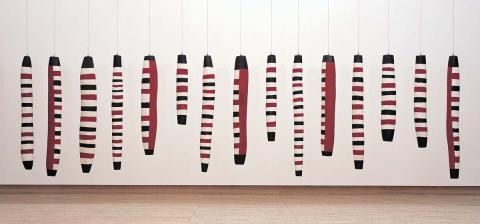Flying Fox Story Place
By Trish Johnson
February 2004
This work, Flying Fox Story Place 2002–03, represents a significant ancestral story for the Winchanam ceremonial group.1 It refers to a sacred totemic site, Kalben (Flying Fox Story Place), and conveys customary laws and beliefs related to the first stage of the Winchanam initiation ritual. The sculpture represents the 'minh mal' (black flying fox) and the 'minh wuk' (small red flying fox) hanging upside down from their tree perches. Flying foxes are abundant in the Cape, nesting in the myriad of mangrove tributaries found along the coastline, and are a traditional food source. Here they are painted in Winchanam ceremonial white-banded body paint. The long, broad, rust-coloured stripes represent the chests of the flying fox.
This story reveals an inherent respect for people and the land and concerns a taboo that was broken by two young brothers, who sneaked out one morning during their initiation period and speared many flying foxes while they were returning to their daytime nesting place among the mangrove trees. After cooking the flying foxes in a 'kap-mar' (ground oven covered with sand) the younger brother tried to encourage the other to return for more. One of the 'kek pith' (bamboo spears) went high up into the air and landed in the Watson River, near the Small Archer River. As the boys tried to swim across and retrieve it, a large rock suddenly began to appear from beneath the water.
Meanwhile, the older men back at the camp removed the sand and bark from the ground oven. They found the flying foxes alive, which then began to fly all around the boys. When the older men realised the two brothers were missing, they went to the Small Archer River and saw the flying foxes pick the two brothers up. The brothers cried out for their parents, admitting that they had done wrong and accepting their punishment. The flying foxes then took them up into the sky to the Milky Way, where two black dots now exist as a reminder to Wik people that the traditional law had been disobeyed. When people of the Small Archer and Watson River areas die, their spirits return to the stone at this site.
Just as his father had handed the stories down to him, Arthur Pambegan Jr has begun handing down the stories and responsibilities to his son, Alair, who assisted him for the first time with the painting of this work. This work was commissioned for the Gallery's 2003 exhibition 'Story Place: Indigenous Art of Cape York and the Rainforest'.
Trish Johnson, Project Officer, Indigenous Australian Art, QAGOMA, February 2004.
Endnotes
- There are a total of five ceremonial groups for the Wik and Kugu peoples around Aurukun on the Western Cape York Peninsula.
Feature image: A view of Flying Fox Story Place 2002–03, installed at the entrance to 'My Country', GOMA, July 2013 / © Estate of the artist / Photograph: M Sherwood, QAGOMA
Connected objects
Related artists
PAMBEGAN, Alair
1966
- present
Full profile
for PAMBEGAN, Alair
Metadata, copyright and sharing information
About this story
- Subject
